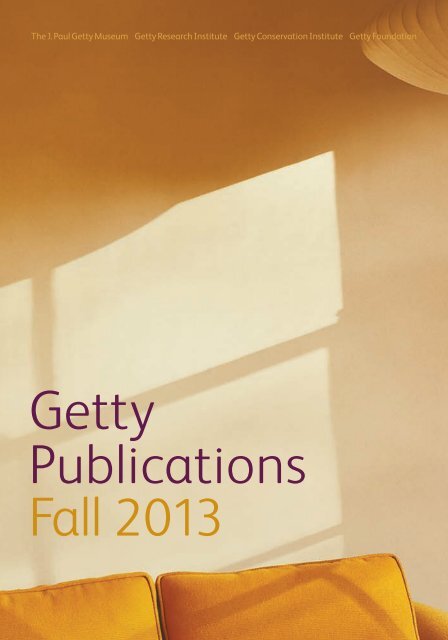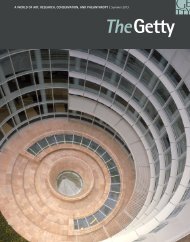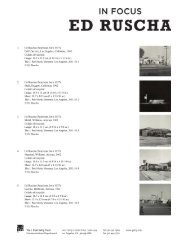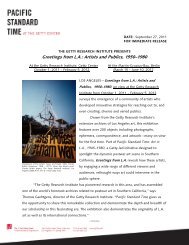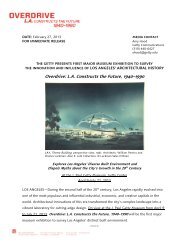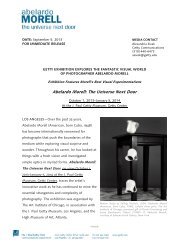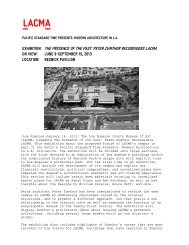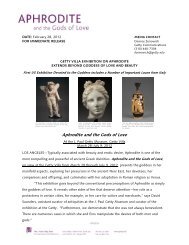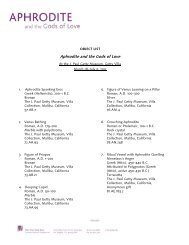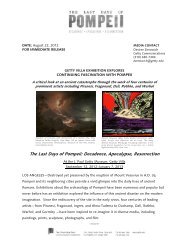Getty Publications Fall 2013 - News from the Getty
Getty Publications Fall 2013 - News from the Getty
Getty Publications Fall 2013 - News from the Getty
Create successful ePaper yourself
Turn your PDF publications into a flip-book with our unique Google optimized e-Paper software.
The J. Paul <strong>Getty</strong> Museum <strong>Getty</strong> Research Institute <strong>Getty</strong> Conservation Institute <strong>Getty</strong> Foundation<br />
<strong>Getty</strong><br />
<strong>Publications</strong><br />
<strong>Fall</strong> <strong>2013</strong>
<strong>Getty</strong> <strong>Publications</strong><br />
To order<br />
Individuals<br />
Visit your local bookstore or call:<br />
800 223-3431 (North America)<br />
310 440-7333 (International)<br />
www.getty.edu/publications<br />
pubsinfo@getty.edu<br />
Bookstores<br />
800 621-2736 (U.S. and Canada)<br />
01235 465 521 (U.K. and Europe)<br />
The J. Paul <strong>Getty</strong> Museum Highlights of <strong>the</strong> Collections<br />
From treasures of <strong>the</strong> ancient world and medieval manuscripts to Renaissance drawings, French<br />
furniture, Impressionist paintings, iconic American photographs, and much more, this app gives<br />
you access to 150 of <strong>the</strong> most beloved objects in <strong>the</strong> <strong>Getty</strong>’s collection. Each object is presented<br />
with an image and a brief discussion, and some also include audio commentary and multiple<br />
views. This multiplatform app brings <strong>the</strong> <strong>Getty</strong>’s most extraordinary artworks and <strong>the</strong> expertise<br />
of its curators to your fingertips.<br />
Mobile App<br />
Sign up for Art Bound, our monthly<br />
electronic newsletter<br />
www.getty.edu/artbound<br />
Find us on Facebook<br />
www.facebook.com/<strong>Getty</strong><strong>Publications</strong><br />
Follow us on Twitter<br />
@<strong>Getty</strong>Pubs<br />
Features:<br />
• Works by Bernini, Leonardo da Vinci, Gauguin, Hockney, Lange, Man Ray, Michelangelo,<br />
Raphael, Rembrandt, Renoir, Stieglitz, Titian, Turner, Warhol, and many o<strong>the</strong>rs<br />
• Nearly 200 images<br />
• Audio commentary on selected works<br />
• Videos that take you behind <strong>the</strong> scenes at <strong>the</strong> <strong>Getty</strong> Center and <strong>Getty</strong> Villa and explore<br />
<strong>the</strong> life of J. Paul <strong>Getty</strong><br />
Available <strong>from</strong> <strong>the</strong> Apple App Store for both iPhone and iPad, Google Play, Amazon Appstore for<br />
Android and Nook Apps.<br />
$2.99<br />
Cover: Uta Barth, German, born Berlin, Germany 1958; lives and works in Los Angeles. Untitled (…and of time. #4), 2000 (Detail). Framed chromogenic prints.<br />
Diptych: 35 x 44 inches (88.9 x 111.8 cm) each panel; 35 x 90 inches (88.9 x 228.6 cm) overall. From The Window in Photographs, p.8<br />
J. Paul GETTY Museum + <strong>Getty</strong> Research institute + <strong>Getty</strong> Conservation INSTITUTE + GETTY foundation
A rich exploration of Victoria’s<br />
portrayal in photography and her<br />
role in shaping <strong>the</strong> medium<br />
<strong>Getty</strong> <strong>Publications</strong> New Titles<br />
A Royal Passion<br />
Queen Victoria and Photography<br />
Anne M. Lyden<br />
With contributions by Sophie Gordon and Jennifer Green-Lewis<br />
In January 1839, photography was announced to <strong>the</strong> world. Two years prior, a young Queen Victoria<br />
ascended to <strong>the</strong> throne of Great Britain and Ireland. These two events, while seemingly unrelated, marked<br />
<strong>the</strong> beginnings of a relationship that continued throughout <strong>the</strong> nineteenth century and helped construct<br />
<strong>the</strong> image of an entire age.<br />
A Royal Passion explores <strong>the</strong> connections between photography and <strong>the</strong> monarchy through Victoria’s<br />
embrace of <strong>the</strong> new medium and her portrayal through <strong>the</strong> lens. Toge<strong>the</strong>r with Prince Albert, her beloved<br />
husband, <strong>the</strong> Queen amassed one of <strong>the</strong> earliest collections of photographs, including works by renowned<br />
photographers such as Roger Fenton, Gustave Le Gray, and Julia Margaret Cameron. Victoria was also <strong>the</strong><br />
first British monarch to have her life recorded by <strong>the</strong> camera: images of her as wife, mo<strong>the</strong>r, widow, and<br />
empress proliferated around <strong>the</strong> world at a time when <strong>the</strong> British Empire spanned <strong>the</strong> globe.<br />
The featured essays consider Victoria’s role in shaping <strong>the</strong> history of photography as well as photography’s<br />
role in shaping <strong>the</strong> image of <strong>the</strong> Queen. Including more than 150 color images—several rarely seen<br />
before—drawn <strong>from</strong> <strong>the</strong> Royal Collection and <strong>the</strong> J. Paul <strong>Getty</strong><br />
Museum, this volume accompanies an exhibition of <strong>the</strong> same<br />
name, on view at <strong>the</strong> J. Paul <strong>Getty</strong> Museum <strong>from</strong> February 4 to<br />
June 20, 2014.<br />
Anne M. Lyden is associate curator in <strong>the</strong> Department of<br />
Photographs at <strong>the</strong> J. Paul <strong>Getty</strong> Museum. Sophie Gordon is<br />
senior curator of photographs at <strong>the</strong> Royal Collection, Windsor.<br />
Jennifer Green-Lewis is associate professor of English literature<br />
at George Washington University, Washington, D.C.<br />
J. Paul <strong>Getty</strong> Museum<br />
232 pages, 9 ½ x 11 ½ inches<br />
120 color and 43 b/w illustrations, 1 map<br />
ISBN 978-1-60606-155-8<br />
US $50.00T [UK £36.00]<br />
february<br />
photography<br />
Charles Clifford, Queen Victoria, 1850s –1860s, J. Paul <strong>Getty</strong> Museum<br />
1
<strong>Getty</strong> <strong>Publications</strong> <strong>Fall</strong> <strong>2013</strong><br />
Opens a window into a rare<br />
and renowned twelfth-century<br />
manuscript<br />
The St. Albans Psalter<br />
Painting and Prayer in Medieval England<br />
Kristen Collins, Peter Kidd, and Nancy Turner<br />
The St. Albans Psalter is one of <strong>the</strong> most important, famous, and puzzling books produced in twelfth-century<br />
England. It was probably created between 1120 and 1140 at St. Albans Abbey, located on <strong>the</strong> site where<br />
Alban, England’s first saint, was martyred.<br />
The manuscript’s powerfully drawn figures and saturated colors are distinct <strong>from</strong> those in previous<br />
Anglo-Saxon painting and signal <strong>the</strong> arrival of <strong>the</strong> Romanesque style of illumination in England. Although<br />
most twelfth-century prayer books were not illustrated, <strong>the</strong> St. Albans Psalter includes more than 40 fullpage<br />
illuminations and over 200 historiated initials. Decorated with gold and precious colors, <strong>the</strong> psalter<br />
offers a display unparalleled by any o<strong>the</strong>r English manuscript to survive <strong>from</strong> <strong>the</strong> period.<br />
In 2007 <strong>the</strong> St. Albans Psalter was removed <strong>from</strong> its binding and in 2012 <strong>the</strong> disbound leaves traveled to<br />
<strong>the</strong> J. Paul <strong>Getty</strong> Museum, where scholars, conservators, and scientists conducted a close examination. New<br />
evidence revealed here challenges several prevailing assumptions about this richly illuminated manuscript.<br />
The St. Albans Psalter is published on <strong>the</strong> occasion of <strong>the</strong> exhibition Canterbury and St. Albans: Treasures<br />
<strong>from</strong> Church and Cloister on view at <strong>the</strong> J. Paul <strong>Getty</strong> Museum <strong>from</strong> September 20, <strong>2013</strong>, to February 2, 2014.<br />
Kristen Collins is associate curator in <strong>the</strong> Department of Manuscripts at <strong>the</strong> J. Paul <strong>Getty</strong> Museum. Peter<br />
Kidd is a freelance researcher specializing in medieval manuscripts. Nancy Turner is manuscripts conservator<br />
in <strong>the</strong> Department of Paper Conservation at <strong>the</strong> J. Paul <strong>Getty</strong> Museum.<br />
J. Paul <strong>Getty</strong> Museum<br />
104 pages, 7 ½ x 10 7 ⁄8 inches<br />
94 color and 2 b/w illustrations<br />
ISBN 978-1-60606-145-9, paper<br />
US $25.00X [UK £18.99]<br />
september<br />
manuscripts<br />
2
Illuminates some of <strong>the</strong> oldest stained<br />
glass—and most famous medieval<br />
paintings—in all of England<br />
<strong>Getty</strong> <strong>Publications</strong> New Titles<br />
The Ancestors of Christ Windows at Canterbury Ca<strong>the</strong>dral<br />
Jeffrey Weaver and Madeline H. Caviness<br />
Eighty-six near-life-size figures of <strong>the</strong> male ancestors of Christ once looked down on <strong>the</strong> choir and eastern<br />
extension of <strong>the</strong> medieval ca<strong>the</strong>dral and priory church of Canterbury. Made of colored glass, with <strong>the</strong><br />
details of <strong>the</strong> faces and costumes painted on <strong>the</strong> surface, <strong>the</strong> ancestors of Christ windows illuminated <strong>the</strong><br />
liturgical areas during all but <strong>the</strong> earliest services in <strong>the</strong> depths of winter, glowing pale blue at dawn and<br />
yellow and red at noon. Dating <strong>from</strong> <strong>the</strong> twelfth century, <strong>the</strong> surviving windows <strong>from</strong> this series are among<br />
<strong>the</strong> oldest panels of stained glass in England, and <strong>the</strong>y are significant examples of what was at <strong>the</strong> time a<br />
relatively new art—monumental stained glass. They are also considered to be among <strong>the</strong> most famous<br />
works of English medieval painting.<br />
This luminously illustrated book discusses <strong>the</strong> original context, iconographic program, and stylistic<br />
development of <strong>the</strong>se windows. It also explores how <strong>the</strong> windows were perceived by various medieval<br />
viewing constituencies, including royals, peasants, princes of <strong>the</strong> church, <strong>the</strong> local Jewish community, and<br />
monks resident at Canterbury.<br />
The Ancestors of Christ Windows at Canterbury Ca<strong>the</strong>dral is published on <strong>the</strong> occasion of <strong>the</strong> exhibition<br />
Canterbury and St. Albans: Treasures <strong>from</strong> Church and Cloister on view at <strong>the</strong> J. Paul <strong>Getty</strong> Museum <strong>from</strong><br />
September 20, <strong>2013</strong>, to February 2, 2014.<br />
Jeffrey Weaver is associate curator in <strong>the</strong> Department of Sculpture and Decorative Arts at <strong>the</strong> J. Paul<br />
<strong>Getty</strong> Museum. Madeline H. Caviness is Mary Richardson Professor Emeritus in <strong>the</strong> Department of Art and<br />
Art History at Tufts University, Medford, Massachusetts.<br />
J. Paul <strong>Getty</strong> Museum<br />
104 pages, 7 ½ x 10 7 ⁄8 inches<br />
63 color and 5 b/w illustrations<br />
ISBN 978-1-60606-146-6, paper<br />
US $25.00X [UK £18.99]<br />
september<br />
art history<br />
3
<strong>Getty</strong> <strong>Publications</strong> <strong>Fall</strong> <strong>2013</strong><br />
This elegantly conceived book<br />
considers <strong>the</strong> making of stained glass<br />
and its enduring iconography<br />
Stained Glass<br />
Radiant Art<br />
Virginia Chieffo Raguin<br />
Stained glass is a monumental art, a corporate enterprise dependent on a patron with whom artists blend<br />
<strong>the</strong>ir voices. Combining <strong>the</strong> fields now labeled decorative arts, architecture, and painting, <strong>the</strong> window transforms<br />
our experience of space. Windows of colored glass were essential features of medieval and Renaissance<br />
buildings. They provided not only light to illuminate <strong>the</strong> interior but also specific and permanent imagery<br />
that proclaimed <strong>the</strong> importance of place. Commissioned by monks, nuns, bishops, and kings, as well as by<br />
merchants, prosperous farmers, and a host of anonymous patrons, <strong>the</strong>se windows vividly reflect <strong>the</strong> social,<br />
religious, civic, and aes<strong>the</strong>tic values of <strong>the</strong>ir eras.<br />
Beautifully illustrated with reproductions <strong>from</strong> <strong>the</strong> remarkable stained glass collection at <strong>the</strong> J. Paul <strong>Getty</strong><br />
Museum, Stained Glass addresses <strong>the</strong> making of a stained glass window, its iconography and architectural<br />
context, <strong>the</strong> patrons and collectors, and <strong>the</strong> challenges of restoration and display. The selected works include<br />
examples <strong>from</strong> Austria, Belgium, England, France, Germany, <strong>the</strong> Ne<strong>the</strong>rlands, and Switzerland. Subject<br />
matter ranges <strong>from</strong> monumental religious scenes for Gothic churches to lively heraldic panels made for houses<br />
and o<strong>the</strong>r secular settings. Integrating comparisons to works of art in o<strong>the</strong>r media, such as manuscripts,<br />
drawings, and panel paintings, this book encourages <strong>the</strong> general reader to see stained glass as an element of<br />
a broad artistic production.<br />
Virginia Chieffo Raguin is distinguished professor of humanities at <strong>the</strong> College of <strong>the</strong> Holy Cross, Worcester,<br />
Massachusetts. She is a member of <strong>the</strong> International Corpus Vitrearum and has published widely on stained<br />
glass, architecture, and religious topics.<br />
J. Paul <strong>Getty</strong> Museum<br />
112 pages, 6 x 9 inches<br />
80 color illustrations<br />
ISBN 978-1-60606-153-4, paper<br />
US $20.00X [UK £16.99]<br />
september<br />
art history<br />
4
This bracing translation lifts a veil<br />
on one of <strong>the</strong> most towering figures<br />
in <strong>the</strong> history of art<br />
<strong>Getty</strong> <strong>Publications</strong> New Titles<br />
The Letters of Paul Cézanne<br />
Edited and translated by Alex Danchev<br />
Revered and misunderstood by his peers and lauded by later generations as <strong>the</strong> fa<strong>the</strong>r of modern art, Paul<br />
Cézanne (1839 –1906) has long been a subject of fascination for artists and art lovers, writers, poets, and<br />
philosophers. His life was a ceaseless artistic quest, and he channeled much of his wide-ranging intellect and<br />
ferocious wit into his letters. Punctuated by exasperated <strong>the</strong>orizing and philosophical reflection, outbursts of<br />
creative ecstasy and melancholic confession, <strong>the</strong> artist’s correspondence reveals both <strong>the</strong> heroic and all-toohuman<br />
qualities of a man who is indisputably among <strong>the</strong> pan<strong>the</strong>on of all-time greats.<br />
This new translation of Cézanne’s letters includes more than twenty that were previously unpublished<br />
and reproduces <strong>the</strong> sketches and caricatures with which Cézanne occasionally illustrated his words. The<br />
letters shed light on some of <strong>the</strong> key artistic relationships of <strong>the</strong> modern period—about one third of<br />
Cézanne’s more than 250 letters are to his boyhood companion Émile Zola, and he communicated extensively<br />
with Camille Pissarro and <strong>the</strong> dealer Ambroise Vollard. The translation is richly annotated with<br />
explanatory notes, and, for <strong>the</strong> first time, <strong>the</strong> letters are cross-referenced to <strong>the</strong> current catalogue raisonné.<br />
Numerous inaccuracies and archaisms in <strong>the</strong> previous English edition of <strong>the</strong> letters are corrected, and<br />
many intriguing passages that were unaccountably omitted have been restored. The result is a publishing<br />
landmark that ably conveys Cézanne’s intricacy of expression.<br />
Alex Danchev is professor of International Relations at <strong>the</strong> University of Nottingham and <strong>the</strong> author of<br />
a number of acclaimed biographies, including Cézanne: A Life (Pan<strong>the</strong>on, 2012) and Georges Braque: A Life<br />
(Arcade, 2012).<br />
J. Paul <strong>Getty</strong> Museum<br />
400 pages, 6 5 ⁄8 x 9 ¼ inches<br />
12 color and 65 b/w illustrations<br />
ISBN 978-1-60606-160-2<br />
US $39.95T<br />
october<br />
NAO<br />
biography<br />
5
<strong>Getty</strong> <strong>Publications</strong> <strong>Fall</strong> <strong>2013</strong><br />
A highly illustrated and easy-to-use<br />
guide to preserving traditional color<br />
photographs<br />
Twentieth-Century Color Photographs<br />
Identification and Care<br />
Sylvie Pénichon<br />
With <strong>the</strong> advent of digital imaging, <strong>the</strong> era of traditional color photography is coming to an end. Yet more<br />
than 150 years after <strong>the</strong> invention of color photography, museums, archives, and personal collections are<br />
full of images to be cherished, studied, and preserved. These photographs, often made with processes and<br />
materials no longer used or easily identified, constitute an important part of <strong>the</strong> cultural and artistic heritage<br />
of <strong>the</strong> twentieth century. Today it is more important than ever to capture <strong>the</strong> technical understanding of <strong>the</strong><br />
processes that created <strong>the</strong>se irreplaceable images.<br />
In providing an accessible overview of <strong>the</strong> history and technology of <strong>the</strong> major traditional color photographic<br />
processes, this abundantly illustrated volume promises to become <strong>the</strong> standard reference in its<br />
field. Following an introductory chapter on color photography in <strong>the</strong> nineteenth century, seven uniformly<br />
structured chapters discuss <strong>the</strong> most commercially or historically significant processes of <strong>the</strong> twentieth<br />
century—additive color screen, pigment, dye imbibition, dye coupling, dye destruction, dye diffusion, and<br />
dye mordanting and silver toning—offering readers a user-friendly guide to materials, methods of identification,<br />
and common kinds of deterioration. A final chapter presents specific guidelines for collection management,<br />
storage, and preservation. There is also a glossary of technical terms, along with appendixes presenting<br />
detailed chronologies for Kodachrome and Ektachrome transparencies, Cibachrome/Ilfochrome printing<br />
materials, and Instant films.<br />
This book will interest instructors and students in classroom settings; conservators, registrars, curators,<br />
archivists, and collection caretakers; and anyone else concerned with <strong>the</strong> long-term preservation of color<br />
photographs.<br />
Sylvie Pénichon is a conservator of photographs at <strong>the</strong> Amon Carter Museum of American Art in Fort<br />
Worth. She has published widely in conservation and photography journals.<br />
<strong>Getty</strong> Conservation Institute<br />
360 pages, 8 x 10 inches<br />
375 color and 70 b/w illustrations<br />
ISBN 978-1-60606-156-5, paper<br />
US $65.00S<br />
october<br />
NAO<br />
photography<br />
6
Explores <strong>the</strong> interplay between<br />
nineteenth-century photography and<br />
Europe’s vision of <strong>the</strong> Middle East<br />
<strong>Getty</strong> <strong>Publications</strong> New Titles<br />
Photography’s Orientalism<br />
New Essays on Colonial Representation<br />
Edited by Ali Behdad and Luke Gartlan<br />
The Middle East played a critical role in <strong>the</strong> development of photography as a new technology and an art<br />
form. Likewise, photography was instrumental in cultivating and maintaining Europe’s distinctively Orientalist<br />
vision of <strong>the</strong> Middle East. As new advances enhanced <strong>the</strong> versatility of <strong>the</strong> medium, nineteenth-century<br />
photographers were able to mass-produce images to incite and satisfy <strong>the</strong> demands of <strong>the</strong> region’s burgeoning<br />
tourist industry and <strong>the</strong> appetites of armchair travelers in Europe. In this way, <strong>the</strong> evolution of<br />
modern photography fueled an interest in visual contact with <strong>the</strong> rest of <strong>the</strong> world.<br />
Photography’s Orientalism offers <strong>the</strong> first in-depth cultural study of <strong>the</strong> works of European and non-<br />
European photographers active in <strong>the</strong> Middle East and India, focusing on <strong>the</strong> relationship between<br />
photographic, literary, and historical representations of this region and beyond. The essays explore<br />
<strong>the</strong> relationship between art and politics by considering <strong>the</strong> connection between <strong>the</strong> European presence<br />
<strong>the</strong>re and aes<strong>the</strong>tic representations produced by traveling and resident photographers, <strong>the</strong>reby contributing<br />
to how <strong>the</strong> history of photography is understood.<br />
Ali Behdad is John Charles Hillis Professor of Literature and chair of <strong>the</strong> English Department at <strong>the</strong><br />
University of California, Los Angeles. His books include Belated Travelers: Orientalism in <strong>the</strong> Age of Colonial<br />
Dissolution (Duke, 1994) and A Forgetful Nation: On Immigration and Cultural Identity in <strong>the</strong> United States<br />
(Duke, 2005). Luke Gartlan is a lecturer in <strong>the</strong> School of Art History at <strong>the</strong> University of St Andrews, Scotland.<br />
His recent publications include “‘Bronzed and Muscular Bodies’: Jinrikishas, Tattooed Bodies, and Yokohama<br />
Photography,” in Transculturation in British Art, 1770 –1930 (Ashgate, 2012). He is also editor designate<br />
(<strong>2013</strong> –14) of <strong>the</strong> journal History of Photography.<br />
<strong>Getty</strong> Research Institute<br />
Issues & Debates series<br />
224 pages, 7 x 10 inches<br />
27 color and 45 b/w illustrations<br />
2 line drawings<br />
ISBN 978-1-60606-151-0, paper<br />
US $35.00S [UK £24.99]<br />
october<br />
photography<br />
7
<strong>Getty</strong> <strong>Publications</strong> <strong>Fall</strong> <strong>2013</strong><br />
Illustrates how <strong>the</strong> window has<br />
provided photography with one of<br />
its richest <strong>the</strong>mes since its inception<br />
The Window in Photographs<br />
Karen Hellman<br />
Photographers have been irresistibly drawn to <strong>the</strong> window as a powerful source of inspiration throughout<br />
<strong>the</strong> history of <strong>the</strong> medium. As one of <strong>the</strong> first camera subjects, <strong>the</strong> window is literally and figuratively<br />
linked to <strong>the</strong> photographic process itself. By bringing toge<strong>the</strong>r key works, arranged <strong>the</strong>matically ra<strong>the</strong>r than<br />
chronologically, and presenting pairings within broader stylistic movements, this volume examines <strong>the</strong><br />
motif of <strong>the</strong> window as a symbol of photographic vision.<br />
The Window in Photographs includes more than eighty color plates spanning <strong>the</strong> history of photography,<br />
all drawn <strong>from</strong> <strong>the</strong> J. Paul <strong>Getty</strong> Museum’s permanent collection. The <strong>the</strong>me is presented in a wide range of<br />
contexts, <strong>from</strong> one of <strong>the</strong> earliest images by William Henry Fox Talbot or Julia Margaret Cameron’s 1864<br />
allegorical use of <strong>the</strong> motif, to works by members of <strong>the</strong> Photo-Secession, including Gertrude Käsebier and<br />
Fred Holland Day. The documentary thread of <strong>the</strong> street photographer can be followed in Eugène Atget’s<br />
record of <strong>the</strong> old quartiers of Paris and later twentieth-century photographs by William Eggleston, Walker<br />
Evans, and Lee Friedlander. Alfred Stieglitz and Paul Strand chose to utilize <strong>the</strong> <strong>the</strong>me of <strong>the</strong> window for its<br />
more graphic possibilities. More recently, photographers Shizuka Yokomizo and Gregory Crewdson explored<br />
conceptual aspects of <strong>the</strong> window to investigate <strong>the</strong>mes of voyeurism and invented narrative, while Uta Barth<br />
and Yuki Onodera created more abstract visions.<br />
The book accompanies <strong>the</strong> exhibition At <strong>the</strong> Window: The Photographer’s View, on view at <strong>the</strong> J. Paul<br />
<strong>Getty</strong> Museum <strong>from</strong> October 1, <strong>2013</strong> to January 5, 2014.<br />
Karen Hellman is assistant curator in <strong>the</strong> Department of Photographs at <strong>the</strong> J. Paul <strong>Getty</strong> Museum.<br />
J. Paul <strong>Getty</strong> Museum<br />
112 pages, 7 ¼ x 8 5 ⁄8<br />
84 color and 4 b/w illustrations<br />
ISBN 978-1-60606-144-2<br />
US $24.95T [UK £16.95]<br />
october<br />
Photography<br />
Additional titles in this series<br />
Photography and Play<br />
ISBN 978-1-60606-107-7<br />
US $24.95T<br />
Photography as Fiction<br />
ISBN 978-1-60606-031-5<br />
US $24.95T<br />
Landscape in Photographs<br />
ISBN 978-1-60606-103-9<br />
US $24.95T<br />
Still Life in Photography<br />
ISBN 978-1-60606-033-9<br />
US $24.95T<br />
The Tree in Photographs<br />
ISBN 978-1-60606-032-2<br />
US $24.95T<br />
8
Highlights images of architecture <strong>from</strong><br />
Greek temples to Gothic ca<strong>the</strong>drals to<br />
modern-day skyscrapers<br />
<strong>Getty</strong> <strong>Publications</strong> New Titles<br />
Architecture in Photographs<br />
Gordon Baldwin<br />
From <strong>the</strong> invention of photography in 1839, architecture was second only to portraiture as <strong>the</strong> most favored<br />
subject for <strong>the</strong> camera. The fact that buildings were immobile was advantageous for <strong>the</strong> long exposures needed<br />
in <strong>the</strong> early days, but architectural images were popular for o<strong>the</strong>r reasons: <strong>the</strong>y documented dynastic, civic, and<br />
religious achievements; educated architects about construction and decorative details; and whetted curiosity<br />
about distant lands. Later photographers found innovative ways to depict structures of every era and type.<br />
Arranged chronologically, Architecture in Photographs spans <strong>the</strong> history of <strong>the</strong> medium and includes<br />
works in a variety of photographic processes by such distinguished nineteenth-century practitioners as Henri<br />
le Secq, Gustave Le Gray, and Roger Fenton; twentieth-century photographers Eugène Atget, Alfred Stieglitz,<br />
and Walker Evans; contemporary artists Ed Ruscha, Lewis Baltz, and Steven Shore; and younger image makers<br />
Ca<strong>the</strong>rine Opie and Michael Wesely.<br />
The seventy-five images presented here, all <strong>from</strong> <strong>the</strong> collection of <strong>the</strong> J. Paul <strong>Getty</strong> Museum, form a<br />
panoply of architectural structures and styles, <strong>from</strong> Egyptian ruins to Greek temples and Gothic ca<strong>the</strong>drals,<br />
and <strong>from</strong> skyscrapers and Modernist schools to mundane vernacular dwellings.<br />
The book is published to coincide with <strong>the</strong> exhibition In Focus: Architecture, on view at <strong>the</strong> J. Paul <strong>Getty</strong><br />
Museum <strong>from</strong> October 15, <strong>2013</strong>, to March 2, 2014.<br />
Gordon Baldwin is an independent curator, a recipient of <strong>the</strong> Rome Prize for his architectural drawings,<br />
and a former curator in <strong>the</strong> Department of Photographs at <strong>the</strong> J. Paul <strong>Getty</strong> Museum.<br />
J. Paul <strong>Getty</strong> Museum<br />
112 pages, 7 ¼ x 8 5 ⁄8<br />
75 color and 4 b/w illustrations<br />
ISBN 978-1-60606-152-7<br />
US $24.95T [UK £16.95]<br />
october<br />
Photography<br />
9
<strong>Getty</strong> <strong>Publications</strong> <strong>Fall</strong> <strong>2013</strong><br />
A revealing look at porcelain<br />
collecting <strong>from</strong> <strong>the</strong> reign of Louis XIV<br />
through <strong>the</strong> eighteenth century<br />
Collecting Chinese and Japanese Porcelain<br />
in Pre-Revolutionary Paris<br />
Stéphane Castelluccio<br />
This beautifully illustrated volume traces <strong>the</strong> changing market for Chinese and Japanese porcelain in Paris<br />
<strong>from</strong> <strong>the</strong> early years of <strong>the</strong> reign of Louis XIV (1643–1715) through <strong>the</strong> eighteenth century. The increase in<br />
<strong>the</strong> quantity and variety of East Asian wares imported during this period spurred efforts to record and analyze<br />
<strong>the</strong>m, resulting in a profusion of inventories, sales catalogues, and treatises. These contemporary sources—<br />
many never published before—provide a comprehensive picture of porcelains: when <strong>the</strong>y were first available;<br />
what kinds were most admired during various periods; where and at what price <strong>the</strong>y were sold; who owned<br />
<strong>the</strong>m; and how <strong>the</strong>y were displayed and used.<br />
Over <strong>the</strong> course of <strong>the</strong>se two centuries, a preference for blue-and-white Chinese works arranged<br />
in crowded, asymmetrical groupings gave way to symmetrical presentations of polychrome and monochrome<br />
Japanese pieces on brackets, tables, and mantelpieces, often mixed with bronzes, marble vases,<br />
and paintings. Some porcelains now received elaborate silver or gilt-bronze mounts. The illustrated pieces,<br />
which include pitchers, vases, lidded bowls, and writing sets, are drawn <strong>from</strong> <strong>the</strong> collections of <strong>the</strong> J. Paul<br />
<strong>Getty</strong> Museum, <strong>the</strong> Victoria and Albert Museum, and <strong>the</strong> Musée des Arts Décoratifs in Paris. Also included<br />
are exquisite porcelains <strong>from</strong> <strong>the</strong> Musée Guimet in Paris, many published here for <strong>the</strong> first time.<br />
Stéphane Castelluccio is chargé de recherche at Le Centre National de la Recheche Scientifique (CNRS),<br />
Centre André Chastel, Paris. He is <strong>the</strong> author of Le Commerce du Luxe à Paris aux XVIIe et XVIIIe (Peter Lang,<br />
AG, 2009) and Les Fastes de la Galerie des Glaces (Payot, 2007).<br />
J. Paul <strong>Getty</strong> Museum<br />
224 pages, 8 x 10 ½ inches<br />
145 color and 16 b/w illustrations<br />
ISBN 978-1-60606-139-8<br />
US $60.00X [UK £40.00]<br />
november<br />
decorative arts<br />
810
Presents a beautifully illustrated<br />
account of Ancient Greek vases and<br />
<strong>the</strong>ir role in human culture<br />
<strong>Getty</strong> <strong>Publications</strong> New Titles<br />
The Greek Vase<br />
Art of <strong>the</strong> Storyteller<br />
John H. Oakley<br />
This richly illustrated volume offers a fascinating introduction to ancient Greek vases for <strong>the</strong> general reader. It<br />
presents vases not merely as beautiful vessels to hold water and wine, but also as instruments of storytelling<br />
and bearers of meaning.<br />
The first two chapters analyze <strong>the</strong> development of different shapes of pottery and relate those shapes to<br />
function, <strong>the</strong> evolution in vase production techniques and decoration, and <strong>the</strong> roles of potters, painters, and<br />
<strong>the</strong>ir workshops. Subsequent chapters focus on vases as <strong>the</strong> primary source of imagery <strong>from</strong> ancient Greece,<br />
offering unique information about mythology, religion, <strong>the</strong>ater, and daily life. The author discusses how to<br />
identify <strong>the</strong> figures and scenes depicted in vase paintings, what <strong>the</strong>se narratives would have meant to <strong>the</strong><br />
people who lived with <strong>the</strong>m and used <strong>the</strong>m, and how <strong>the</strong>y <strong>the</strong>refore reflect <strong>the</strong> cultural values of <strong>the</strong>ir time.<br />
Also examined is <strong>the</strong> impact Greek vases had on <strong>the</strong> art, architecture, and literature of subsequent generations.<br />
Based on <strong>the</strong> rich collections of <strong>the</strong> British Museum and <strong>the</strong> J. Paul <strong>Getty</strong> Museum, <strong>the</strong> exquisite<br />
details of <strong>the</strong> works offer <strong>the</strong> reader <strong>the</strong> opportunity for an intimate interaction with <strong>the</strong> graphic beauty<br />
and narrative power of ancient vases often not available<br />
in a gallery setting.<br />
John H. Oakley is Chancellor Professor and Forrest D.<br />
Murden, Jr. Professor in <strong>the</strong> Department of Classical Studies<br />
at <strong>the</strong> College of William and Mary, Williamsburg, Virginia.<br />
He is <strong>the</strong> editor of and a contributer to A<strong>the</strong>nian Potters and<br />
Painters (American School of Classical Studies, 1994) and<br />
author of The Achilles Painter (Philipp von Zabern, 1997).<br />
J. Paul <strong>Getty</strong> Museum<br />
114 pages, 10 x 10 ½ inches<br />
130 color illustrations<br />
ISBN 978-1-60606-147-3<br />
US $29.95T<br />
october<br />
NAO<br />
Antiquities<br />
The Greek hero Theseus battles <strong>the</strong> Minotaur. Storage Jar; Group E,<br />
Greek (A<strong>the</strong>ns), ca 550 B.C., terracotta. J.Paul <strong>Getty</strong> Museum, 85.AE.376<br />
11
<strong>Getty</strong> <strong>Publications</strong> <strong>Fall</strong> <strong>2013</strong><br />
The Conservation of Cave 85 at<br />
<strong>the</strong> Mogao Grottoes, Dunhuang<br />
A Collaborative Project of <strong>the</strong> <strong>Getty</strong> Conservation<br />
Institute and <strong>the</strong> Dunhuang Academy<br />
Edited by Lori Wong and Neville Agnew<br />
The Mogao Grottoes, a World Heritage Site in northwestern<br />
China, are located along <strong>the</strong> ancient caravan routes—collectively<br />
known as <strong>the</strong> Silk Road—that once linked China<br />
with <strong>the</strong> West. Founded by a Buddhist monk in <strong>the</strong> late fourth<br />
century, Mogao flourished over <strong>the</strong> following millennium,<br />
as monks, local rulers, and travelers commissioned hundreds<br />
of cave temples cut into a mile-long rock cliff and adorned<br />
<strong>the</strong>m with vibrant murals. More than 490 decorated grottoes<br />
remain, containing thousands of sculptures and some<br />
45,000 square meters of wall paintings, making Mogao<br />
one of <strong>the</strong> world’s most significant sites of Buddhist art.<br />
In 1997 <strong>the</strong> <strong>Getty</strong> Conservation Institute, which had<br />
been working with <strong>the</strong> Dunhuang Academy since 1989,<br />
began a case study using <strong>the</strong> Late–Tang dynasty Cave 85 to<br />
develop a methodology that would stabilize <strong>the</strong> deteriorating<br />
wall paintings. This abundantly illustrated volume is <strong>the</strong><br />
definitive report on <strong>the</strong> project, which was completed in 2010.<br />
Lori Wong is a wall painting conservator and project<br />
specialist at <strong>the</strong> <strong>Getty</strong> Conservation Institute. Neville Agnew,<br />
senior principal project specialist at <strong>the</strong> <strong>Getty</strong> Conservation<br />
Institute, is coauthor of Cave Temples of Mogao: Art and<br />
History on <strong>the</strong> Silk Road (<strong>Getty</strong> <strong>Publications</strong>, 2001) and editor<br />
of Conservation of Ancient Sites on <strong>the</strong> Silk Road (<strong>Getty</strong><br />
<strong>Publications</strong>, 2010).<br />
World Antiquarianism<br />
Comparative Perspectives<br />
Edited by Alain Schnapp<br />
With Lothar von Falkenhausen, Peter N. Miller,<br />
and Tim Murray<br />
The term antiquarianism refers to engagement with <strong>the</strong><br />
material heritage of <strong>the</strong> past—an engagement that preceded<br />
<strong>the</strong> modern academic discipline of archaeology.<br />
Antiquarian activities result in <strong>the</strong> elaboration of particular<br />
social behaviors and <strong>the</strong> production of tools for exploring<br />
<strong>the</strong> collective memory.<br />
This book is <strong>the</strong> first to compare antiquarianism in a<br />
global context, examining its roots in <strong>the</strong> ancient Near<br />
East, its flourishing in early modern Europe and East Asia,<br />
and its manifestations in nonliterate societies of Melanesia<br />
and Polynesia. By establishing wide-reaching geographical<br />
and historical perspectives, <strong>the</strong> essays reveal <strong>the</strong> universality<br />
of antiquarianism as an embodiment of <strong>the</strong> human<br />
mind and open new avenues for understanding <strong>the</strong> representation<br />
of <strong>the</strong> past, <strong>from</strong> ancient societies to <strong>the</strong> present.<br />
Alain Schnapp is professor of classical archaeology<br />
at <strong>the</strong> Université Paris I–Panthéon-Sorbonne and director<br />
of <strong>the</strong> Institut d’études avancées (IEA-Paris). Lothar von<br />
Falkenhausen is professor of Chinese archaeology at <strong>the</strong><br />
University of California, Los Angeles. Peter N. Miller is professor<br />
of modern history and dean of <strong>the</strong> Bard Graduate<br />
Center for Decorative Arts, Design History, and Material<br />
Culture, New York. Tim Murray is professor of archaeology<br />
and dean of <strong>the</strong> faculty of humanities and social sciences<br />
at La Trobe University, Melbourne.<br />
12<br />
<strong>Getty</strong> Conservation Institute<br />
458 pages, 8 ½ x 11 inches<br />
500 color and 50 b/w illustrations<br />
50 line drawings, 1 map<br />
ISBN 978-1-60606-157-2, paper<br />
US $60.00S [UK £45.00]<br />
february<br />
conservation<br />
<strong>Getty</strong> Research Institute<br />
Issues & Debates series<br />
464 pages, 7 x 10 inches<br />
23 color and 81 b/w illustrations, 4 maps<br />
ISBN 978-1-60606-148-0, paper<br />
US $60.00S [UK £40.00]<br />
february<br />
art history
A new translation of a seminal<br />
sixteenth-century book on <strong>the</strong><br />
collection and display of objects<br />
<strong>Getty</strong> <strong>Publications</strong> New Titles<br />
The First Treatise on Museums<br />
Samuel Quiccheberg’s Inscriptiones, 1565<br />
Samuel Quiccheberg<br />
Introduction by Mark A. Meadow<br />
Translation by Mark A. Meadow and Bruce Robertson<br />
Samuel Quiccheberg’s Inscriptiones, first published in Latin in 1565, is an ambitious effort to demonstrate<br />
<strong>the</strong> pragmatic value of curiosity cabinets, or Wunderkammern, to princely collectors in sixteenth-century<br />
Europe and, by so doing, inspire <strong>the</strong>m to develop <strong>the</strong>ir own such collections. Quiccheberg shows how <strong>the</strong><br />
assembly and display of physical objects offered nobles a powerful means to expand visual knowledge,<br />
allowing <strong>the</strong>m to incorporate empirical and artisanal expertise into <strong>the</strong> realm of <strong>the</strong> written word. But in<br />
mapping out <strong>the</strong> collectability of <strong>the</strong> material world, Quiccheberg did far more than create a taxonomy. Ra<strong>the</strong>r,<br />
he demonstrated how organizing objects made <strong>the</strong>ir knowledge more accessible; how objects, when juxtaposed<br />
or grouped, could tell a story; and how such strategies could enhance <strong>the</strong> value of any single object.<br />
Quiccheberg’s descriptions of early modern collections provide both a point of origin for today’s museums<br />
and an implicit critique of <strong>the</strong>ir aims, asserting <strong>the</strong> fundamental research and scholarly value of collections:<br />
collections are to be used, not merely viewed. The First Treatise on Museums makes Quiccheberg’s now<br />
rare publication available in an English translation. Complementing <strong>the</strong> translation are a critical introduction<br />
by Mark A. Meadow and a preface by Bruce Robertson.<br />
Mark A. Meadow is associate professor in <strong>the</strong> Department of History of Art and Architecture at <strong>the</strong><br />
University of California, Santa Barbara. His publications include Pieter Bruegel <strong>the</strong> Elder’s Ne<strong>the</strong>rlandish<br />
Proverbs and <strong>the</strong> Practice of Rhetoric (Waanders: Zwolle, 2002) and a translation of Symon Andriessoon’s<br />
Duytsche Adagia ofte Spreecwoorden (Verloren: Hilversum, 2003). Bruce Robertson is professor in <strong>the</strong><br />
Department of History of Art and Architecture and director of <strong>the</strong> Art, Design & Architecture Museum at<br />
<strong>the</strong> University of California, Santa Barbara.<br />
<strong>Getty</strong> Research Institute<br />
Texts & Documents series<br />
188 pages, 7 x 10 inches<br />
8 color and 17 b/w illustrations<br />
ISBN 978-1-60606-149-7, paper<br />
US $30.00S [UK £19.99]<br />
january<br />
art history<br />
13
<strong>Getty</strong> <strong>Publications</strong> <strong>Fall</strong> <strong>2013</strong><br />
14<br />
Introduction to Controlled<br />
Vocabularies<br />
Terminology for Art, Architecture,<br />
and O<strong>the</strong>r Cultural Works<br />
Updated Edition<br />
Patricia Harpring<br />
Series edited by Murtha Baca<br />
This primer on <strong>the</strong> characteristics, scope, uses, and methods<br />
for building and maintaining controlled vocabularies for art<br />
and cultural materials explains how vocabularies should be<br />
integrated in cataloging systems; utilized for indexing and<br />
retrieval; and structured to group synonyms and arrange<br />
concepts into categories.<br />
The updated edition reflects recent developments in <strong>the</strong><br />
field, including new national and international standards,<br />
current trends such as Linked Open Data, and revisions to <strong>the</strong><br />
<strong>Getty</strong> vocabularies. The glossary and bibliography have also<br />
been updated.<br />
Patricia Harpring is managing editor of <strong>the</strong> <strong>Getty</strong><br />
Vocabulary Program, where she supervises contributions<br />
and editorial work for <strong>the</strong> Art & Architecture Thesaurus<br />
(AAT), Union List of Artist Names (ULAN), <strong>Getty</strong> Thesaurus<br />
of Geographic Names (TGN), and Cultural Objects Name<br />
Authority (CONA). Murtha Baca is head of Digital Art History<br />
at <strong>the</strong> <strong>Getty</strong> Research Institute. Her publications include<br />
Cataloging Cultural Objects: A Guide to Describing Cultural<br />
Works and Their Images (2006) and Introduction to Metadata<br />
(<strong>Getty</strong> <strong>Publications</strong>, 2008).<br />
<strong>Getty</strong> Research Institute<br />
Intro To series<br />
258 pages, 7 x 9 ½ inches<br />
68 b/w illustrations<br />
4 line drawings<br />
ISBN 978-1-60606-150-3, paper<br />
US $50.00S [UK £34.99]<br />
october<br />
Reference<br />
Conservation Practices on<br />
Archaeological Excavations<br />
Principles and Methods<br />
Corrado Pedelì and Stefano Pulga, translated by Erik Risser<br />
The relationship between archaeology and conservation<br />
has long been complex and, at times, challenging. Archaeologists<br />
are often seen as interested principally in excavation<br />
and research, while conservators are concerned<br />
mainly with stabilization and <strong>the</strong> prevention of deterioration.<br />
Yet it is often initial conservation in <strong>the</strong> field that<br />
determines <strong>the</strong> long-term survival and intelligibility of<br />
both moveable artifacts and fixed architectural features.<br />
This user-friendly guide to conservation practices on<br />
archaeological excavations covers both structures and artifacts,<br />
starting <strong>from</strong> <strong>the</strong> moment when <strong>the</strong>y are uncovered.<br />
Individual chapters discuss excavation and conservation,<br />
environmental and soil issues, deterioration, identification<br />
and condition assessment, detachment and removal, initial<br />
cleaning, coverings and shelters, packing, and documentation.<br />
There are also eight appendixes.<br />
Geared primarily for professionals engaged in <strong>the</strong><br />
physical practice of excavation, this book will also interest<br />
archaeologists, archaeological conservators, site managers,<br />
conservation scientists, museum curators, and students of<br />
archaeology and conservation.<br />
Corrado Pedelì is senior conservator/restorer with <strong>the</strong><br />
Superintendence for Cultural Heritage of <strong>the</strong> Aosta Valley<br />
Regional Administration in Italy. Stefano Pulga is a freelance<br />
restorer based in Aosta. Erik Risser is assistant conservator in<br />
<strong>the</strong> Department of Antiquities at <strong>the</strong> J. Paul <strong>Getty</strong> Museum.<br />
<strong>Getty</strong> Conservation Institute<br />
168 pages, 7 5 ⁄8 x 10 3 ⁄8 inches<br />
88 b/w illustrations<br />
ISBN 978-1-60606-158-9, paper<br />
US $50.00S [UK £36.00]<br />
february<br />
conservation
<strong>Getty</strong> Digital<br />
This enhanced e-book considers<br />
<strong>the</strong> mystery surrounding one of<br />
Rubens’s most intriguing works<br />
<strong>Getty</strong> <strong>Publications</strong> Digital<br />
Looking East<br />
Rubens’s Encounter with Asia<br />
Edited by Stephanie Schrader<br />
With contributions by Burglind Jungmann, Kim Young-Jae, and Christine Göttler<br />
Available on <strong>the</strong> Apple iBookstore as well as in print, Looking East explores Peter Paul Rubens’s fascinating<br />
depiction of a man wearing Korean costume. Made around 1617, Man in Korean Costume has intrigued<br />
scholars since its creation. Despite <strong>the</strong> drawing’s renown, however, <strong>the</strong> reasons why it was made and<br />
whe<strong>the</strong>r it actually depicts a specific Asian person remain a mystery. The dramatic story that develops<br />
involves a shipwreck, an unusual hat, <strong>the</strong> earliest trade between Europe and Asia, <strong>the</strong> trafficking of Asian<br />
slaves, and <strong>the</strong> role of Jesuit missionaries in Asia.<br />
The book traces <strong>the</strong> interpretations and meanings ascribed to this drawing over <strong>the</strong> centuries. Could<br />
Rubens have actually encountered a particular Korean man who sailed to Europe, or did he instead draw a<br />
model wearing Asian clothing, or did he simply hear about such a person? What did Europeans really know<br />
about Korea during that period, and what might <strong>the</strong> Jesuits have had to do with <strong>the</strong> production of this<br />
drawing? All of <strong>the</strong>se questions are pondered <strong>from</strong> various points of view by <strong>the</strong> book’s contributors.<br />
Published to accompany an exhibition of <strong>the</strong> same name held at <strong>the</strong> J. Paul <strong>Getty</strong> Museum, this<br />
enhanced e-book includes a complete image gallery of <strong>the</strong> works in and related to <strong>the</strong> exhibition, in<br />
addition to <strong>the</strong> essays <strong>from</strong> <strong>the</strong> print volume.<br />
Stephanie Schrader is associate curator in <strong>the</strong> Department of Drawings at <strong>the</strong> J. Paul <strong>Getty</strong> Museum.<br />
She was a contributor to <strong>the</strong> Metropolitan Museum of Art’s exhibition catalogue Man, Myth, and Sensual<br />
Pleasures: Jan Gossart’s Renaissance (2010).<br />
J. Paul <strong>Getty</strong> Museum<br />
E-book<br />
http://bit.ly/LookingEast<br />
ISBN 978-1-60606-159-6<br />
US $9.99 [UK £6.49]<br />
now available<br />
drawings<br />
15
<strong>Getty</strong> <strong>Publications</strong> <strong>Fall</strong> <strong>2013</strong><br />
<strong>Getty</strong> Digital<br />
Crucial primary evidence for<br />
art historians published in<br />
open access on <strong>the</strong> Web<br />
Digital Mellini<br />
An Electronic Collaborative Critical Facsimile Edition<br />
Pietro Mellini<br />
Edited by Murtha Baca and Nuria Rodríguez Ortega with Francesca Cappelletti and Helen Glanville<br />
This is <strong>the</strong> first electronic facsimile edition published by <strong>the</strong> <strong>Getty</strong> Research Institute. Its focus is an<br />
unpublished manuscript, written by Pietro Mellini in 1681, that contains an inventory of <strong>the</strong> collection of<br />
paintings and drawings owned by his family in Rome. Unlike <strong>the</strong> conventional legal inventories of <strong>the</strong> day,<br />
this document was written in <strong>the</strong> form of a poem in terza rima, <strong>the</strong> rhyme scheme used by Dante in The<br />
Divine Comedy. Mellini’s verse inventory reveals much about taste, social status, and collecting trends in<br />
Baroque Rome.<br />
Digital Mellini is <strong>the</strong> result of research conducted in a collaborative online environment. It includes a<br />
digital facsimile of <strong>the</strong> Mellini manuscript; an annotated transcription of <strong>the</strong> original Italian text; translations<br />
into English and Spanish; critical essays that place <strong>the</strong> manuscript in its historical context; a selected<br />
bibliography; and a concordance with a conventional inventory of <strong>the</strong> same collection drawn up in 1680.<br />
The format provides a methodological model for conducting and publishing art-historical research in <strong>the</strong><br />
age of <strong>the</strong> Internet.<br />
Murtha Baca is head of digital art history at <strong>the</strong> <strong>Getty</strong> Research Institute. Nuria Rodríguez Ortega is<br />
chair of <strong>the</strong> department of art history at <strong>the</strong> Universidad de Málaga in Spain. Francesca Cappelletti is a<br />
professor of art history at <strong>the</strong> Università di Ferrara in Italy. Helen Glanville is a research associate at <strong>the</strong><br />
Hamilton Kerr Institute of <strong>the</strong> Fitzwilliam Museum at <strong>the</strong> University of Cambridge.<br />
<strong>Getty</strong> Research Institute<br />
ISBN 978-1-60606-161-9<br />
FREE<br />
august<br />
art history<br />
16
A copiously illustrated examination<br />
of European bronze restoration<br />
available free online<br />
<strong>Getty</strong> <strong>Publications</strong> Digital<br />
The Restoration<br />
of Ancient Bronzes<br />
NAPLES AND BEYOND<br />
Edited by Erik Risser and David Saunders<br />
The Restoration of Ancient Bronzes<br />
Naples and Beyond<br />
Edited by Erik Risser and David Saunders<br />
The archaeological finds at Herculaneum and Pompeii have rendered Naples an especially rich field for<br />
<strong>the</strong> study of <strong>the</strong> history of restorations. This is particularly true of ancient bronzes, which were found <strong>the</strong>re<br />
in unparalleled quantity and variety. Their discovery and <strong>the</strong> desire to display <strong>the</strong>m prompted innovation,<br />
experimentation, and legislation. Bringing toge<strong>the</strong>r <strong>the</strong> research of an international group of curators,<br />
conservators, archivists, and scientists, this extensively illustrated online volume examines <strong>the</strong> evolving<br />
practice of bronze restoration in Naples and o<strong>the</strong>r European centers—notably Florence, Paris, and Berlin—<br />
<strong>from</strong> <strong>the</strong> eighteenth century until today.<br />
Presenting <strong>the</strong> results of new investigations into <strong>the</strong> history of many famous as well as some lesser-known<br />
ancient bronzes, <strong>the</strong> essays and case studies selected for this publication address <strong>the</strong> contexts in which <strong>the</strong><br />
restorations took place; <strong>the</strong> techniques and materials used; <strong>the</strong> role of specialists; and changing attitudes to<br />
<strong>the</strong> display of <strong>the</strong>se statues. Along with a rich selection of images—including general views, archival images,<br />
technical details, and x-rays of <strong>the</strong> objects under discussion—<strong>the</strong>se texts offer a significant contribution to<br />
<strong>the</strong> history of restoration and conservation, providing valuable information regarding <strong>the</strong> evolution of taste<br />
and museum practices at a formative stage of modern archaeology.<br />
Erik Risser is assistant conservator in <strong>the</strong> Department of Antiquities at <strong>the</strong> J. Paul <strong>Getty</strong> Museum. David<br />
Saunders is assistant curator in <strong>the</strong> Department of Antiquities at <strong>the</strong> J. Paul <strong>Getty</strong> Museum.<br />
J. Paul <strong>Getty</strong> Museum<br />
228 pages, online publication<br />
169 color and 69 b/w illustrations<br />
30 line drawings<br />
ISBN 978-1-60606-154-1<br />
Free<br />
october<br />
sculpture<br />
17
<strong>Getty</strong> <strong>Publications</strong> <strong>Fall</strong> <strong>2013</strong><br />
Recent <strong>Publications</strong><br />
978-1-60606-128-2, HC<br />
US $59.95T, UK £39.95<br />
978-1-60606-135-0, HC<br />
US $50.00X, UK £34.95<br />
978-1-60606-131-2, PA<br />
US $20.00X, UK £13.99<br />
978-1-60606-121-3, HC<br />
US $29.95T, UK £19.95<br />
978-1-60606-137-4, PA<br />
US $50.00X, UK £34.99<br />
978-1-60606-138-1, PA<br />
US $24.95T, UK £16.95<br />
978-1-60606-133-6, HC<br />
US $60.00X, UK £39.95<br />
978-60606-134-3, PA<br />
US $50.00X, UK £34.99<br />
978-1-60606-122-0, PA<br />
US $40.00S, UK £27.99<br />
18
978-1-60606-142-8, PA<br />
US $70.00S, UK £49.99<br />
978-1-60606-132-9, HC<br />
US $49.95T, UK £34.95<br />
978-1-60606-118-3, PA<br />
US $20.00X, NAO<br />
<strong>Getty</strong> <strong>Publications</strong> Selected Backlist cations<br />
Selected Backlist<br />
978-1-60606-124-4, PA<br />
US $70.00S, UK £49.99<br />
978-1-60606-141-1, PA<br />
US $20.00S, UK £13.95<br />
978-1-60606-143-5, HC<br />
US $19.95T, UK £14.95<br />
978-1-60606-129-9, HC<br />
US $45.00X, NAO<br />
978-1-60606-117-6, PA<br />
US $35.00X, NAO<br />
978-1-60606-130-5, HC<br />
US $14.95T, UK £9.95<br />
19
Job No:02-10363 Title:Song Of The Swallows-Test<br />
#175 SQ Dtp 48 Page:Jkt<br />
<strong>Getty</strong> <strong>Publications</strong> <strong>Fall</strong> <strong>2013</strong><br />
Children’s Books<br />
978-1-60606-094-0, HC<br />
US $17.95T, UK £12.95<br />
978-1-60606-050-6, HC<br />
US $16.95T, NAO<br />
978-0-89236-999-7, HC<br />
US $17.95T, UK £10.95<br />
978-0-89236-989-8, HC<br />
US $16.95T, UK £10.95<br />
978-0-89236-618-7, HC<br />
US $17.95T, COBEE<br />
978-1-60606-003-2, HC<br />
US $16.95T, UK £10.95<br />
978-0-89236-990-4, HC<br />
US $14.95T, UK £9.95<br />
978-1-60606-085-8, HC<br />
US $19.95T, £12.95<br />
978-1-60606-012-4, HC<br />
US $19.95T, UK £12.95<br />
20
Looking At Series<br />
<strong>Getty</strong> <strong>Publications</strong> Selected Backlist<br />
978-0-89236-981-2, PA<br />
US $19.95T, UK £12.99<br />
978-0-89236-750-4, PA<br />
US $19.95T, COBEE<br />
978-0-89236-708-5, PA<br />
US $19.95T, UK £12.99<br />
978-0-89236-972-0, PA<br />
US $19.95T, UK £12.99<br />
978-0-89236-971-3, PA<br />
US $19.95T, UK £12.99<br />
978-0-89236-871-6, PA<br />
US $19.95T, NAO<br />
978-1-60606-080-3, PA<br />
US $19.95T, UK £12.99<br />
978-0-89236-599-9, PA<br />
US $19.95T, UK £12.99<br />
Also in this series:<br />
Looking at European Ceramics, 978-0-89236-216-5, PA, US $19.95T, COBEE<br />
Looking at European Sculpture, 978-0-89236-291-2, PA, US $19.95T, COBEE<br />
978-0-89236-217-2, PA<br />
US $19.95T, COBEE<br />
21
<strong>Getty</strong> <strong>Publications</strong> <strong>Fall</strong> <strong>2013</strong><br />
A Guide to Imagery Series<br />
978-0-89236-830-3, PA<br />
US $24.95T, UK £16.99<br />
978-0-89236-860-0, PA<br />
US $24.95T, UK £16.99<br />
978-0-89236-907-2, PA<br />
US $24.95T, UK £16.99<br />
978-0-89236-947-8, PA<br />
US $24.95T, UK £16.99<br />
978-0-89236-914-0, PA<br />
US $24.95T, UK £16.99<br />
978-0-89236-885-3, PA<br />
US $24.95T, UK £16.99<br />
978-0-89236-702-3, PA<br />
US $24.95T, UK £16.99<br />
978-0-89236-727-6, PA<br />
US $24.95T, UK £16.99T<br />
978-0-89236-936-2, PA<br />
US $24.95T, UK £16.99<br />
22
<strong>Getty</strong> <strong>Publications</strong> Selected Backlist<br />
978-0-89236-845-7, PA<br />
US $24.95T, UK £16.99<br />
978-1-60606-009-4, PA<br />
US $24.95T, UK £16.99<br />
978-1-60606-044-5, PA<br />
US $24.95T, UK £16.99<br />
978-0-89236-965-2, PA<br />
US $24.95T, UK £16.99<br />
978-0-89236-772-6, PA<br />
US $24.95T, UK £16.99<br />
978-0-89236-745-0, PA<br />
US $24.95T, UK £16.99<br />
978-0-89236-717-7, PA<br />
US $24.95T, UK £16.99<br />
978-0-89236-818-1, PA<br />
US $24.95T, UK £16.99<br />
978-1-60606-066-7, PA<br />
US $24.95T, UK £16.99<br />
23
<strong>Getty</strong> <strong>Publications</strong> <strong>Fall</strong> <strong>2013</strong><br />
24<br />
This catalog presents books scheduled<br />
for publication and distribution <strong>from</strong><br />
September 1, <strong>2013</strong>, to February 28,<br />
2014. All prices and/or publication dates<br />
are subject to change without notice.<br />
orders for individuals<br />
Items may be ordered using MasterCard, Visa,<br />
or American Express between 9:00 a.m. and<br />
5:00 p.m. Pacific time, Monday through Friday.<br />
800 223-3431 North America<br />
310 440-7333 International<br />
310 440-7742 Fax<br />
orders@getty.edu<br />
www.getty.edu/publications<br />
<strong>Getty</strong> <strong>Publications</strong><br />
Distribution Center<br />
Dept. TFC3<br />
1200 <strong>Getty</strong> Center Drive, Suite 1200<br />
Los Angeles, CA 90049<br />
Please contact <strong>the</strong> customer service department<br />
for shipping rates. California sales tax will be<br />
added to all orders shipped to California.<br />
DESK COPIES<br />
To request a desk copy of a book that has already<br />
been adopted for course use, please submit a<br />
request on school letterhead with <strong>the</strong> title of <strong>the</strong><br />
course, expected enrollment, and <strong>the</strong> name of <strong>the</strong><br />
bookstore that placed <strong>the</strong> order. Mail your request<br />
to “Attn: Desk Copies” at <strong>the</strong> address below.<br />
Requests can also be faxed to 310 440-7758.<br />
EXAMINATION COPIES<br />
To request an examination copy, please send<br />
on school letterhead <strong>the</strong> name and description<br />
of <strong>the</strong> course, expected enrollment, and term<br />
in which it will be taught. Mail your request to<br />
“Attn: Exam Copies” at <strong>the</strong> address below.<br />
For books less than $35, please enclose <strong>the</strong> cost<br />
of shipping and handling ($5 per book) with your<br />
request. We do not guarantee that all requests<br />
will be fulfilled. For books $35 or more, we offer<br />
a 20% professional discount plus shipping and<br />
handling ($5 per book). Prepayment by check or<br />
credit card (MasterCard, Visa, American Express)<br />
is required.<br />
REVIEW COPIES<br />
Requests for review copies should be sent<br />
on media letterhead. Mail <strong>the</strong> request to <strong>the</strong><br />
Marketing Department at <strong>the</strong> address below.<br />
Requests can also be faxed to 310 440-7758<br />
or e-mailed to publicity@getty.edu.<br />
MAILING ADDRESS FOR DESK, EXAM,<br />
AND REVIEW COPIES<br />
<strong>Getty</strong> <strong>Publications</strong><br />
Marketing Department<br />
1200 <strong>Getty</strong> Center Drive, Suite 500<br />
Los Angeles, CA 90049<br />
Area Sales Restrictions<br />
OBE<br />
World rights except United Kingdom<br />
and Commonwealth<br />
COBE<br />
Not for sale in Commonwealth except Canada<br />
COBEE<br />
Not for sale in Commonwealth and Europe<br />
except Canada<br />
USA<br />
For sale in <strong>the</strong> United States and its<br />
dependencies only<br />
NAO<br />
For sale in North America only<br />
U.S. and canadian TRADE DISTRIBUTION<br />
Chicago Distribution Center<br />
11030 South Langley<br />
Chicago, IL 60628<br />
800 621-2736 Telephone<br />
800 621-8476 Fax<br />
custserv@press.uchicago.edu<br />
u.s. sales representation<br />
Arizona, California, Metro New York, Nevada,<br />
New Mexico, Texas<br />
Gary Hart<br />
818 956-0527 Telephone<br />
818 243-4676 Fax<br />
ghart@press.uchicago.edu<br />
Connecticut, Delaware, Eastern Pennsylvania,<br />
Maine, Maryland, Massachusetts,<br />
New Hampshire, New Jersey, Rhode Island,<br />
Vermont, Washington DC<br />
Blake DeLodder<br />
301 322-4509 Telephone<br />
301 583-0376 Fax<br />
bdelodder@press.uchicago.edu<br />
Illinois, Indiana, Iowa, Kentucky, Michigan,<br />
Minnesota, Nebraska, North Dakota, Ohio,<br />
South Dakota, Western New York, Western<br />
Pennsylvania, Wisconsin<br />
Bailey Walsh<br />
608 218-1669 Telephone<br />
608 218-1670 Fax<br />
bwalsh@press.uchicago.edu<br />
Alaska, Colorado, Hawaii, Idaho, Montana,<br />
Oregon, Utah, Washington, Wyoming<br />
George Carroll<br />
Redsides Publishing Services<br />
425 922-1045 Telephone<br />
425 671-0362 Fax<br />
geocarroll@earthlink.net<br />
Oklahoma<br />
Judy Stevenson<br />
Sou<strong>the</strong>rn Territory Associates<br />
806 799-9997 Telephone<br />
806 799-9777 Fax<br />
sta77@suddenlink.net<br />
Florida (except Panhandle), Sou<strong>the</strong>rn Georgia<br />
Geoff Rizzo<br />
Sou<strong>the</strong>rn Territory Associates<br />
772 223-7776 Telephone<br />
772 223-7131 Fax<br />
rizzosta@yahoo.com<br />
Nashville, TN<br />
Janet Fairchild<br />
Sou<strong>the</strong>rn Territory Associates<br />
931 358-9446 Telephone<br />
931 358-5892 Fax<br />
jhfsta@aol.com<br />
North Carolina, South Carolina, Virginia,<br />
Knoxville, TN<br />
Angie Smits<br />
Sou<strong>the</strong>rn Territory Associates<br />
336 574-1879 Telephone<br />
336 275-3290 Fax<br />
hasmits@aol.com<br />
Nor<strong>the</strong>rn Louisiana; Arkansas; Nor<strong>the</strong>rn<br />
Mississippi; Memphis, TN<br />
Rayner Krause<br />
Sou<strong>the</strong>rn Territory Associates<br />
972 618-1149 Telephone/Fax<br />
knrkrause@aol.com<br />
Georgia; Chattanooga, TN; Florida Panhandle<br />
Teresa Rolfe Kravtin<br />
Sou<strong>the</strong>rn Territory Associates<br />
706 882-9014 Telephone<br />
706 882-4105 Fax<br />
trkravtin@charter.net<br />
Sou<strong>the</strong>rn Louisiana, Sou<strong>the</strong>rn Mississippi,<br />
Coastal Alabama<br />
Sou<strong>the</strong>rn Territory Associates<br />
806 799-9997 Telephone<br />
806 799-9777 Fax<br />
sta77@suddenlink.net<br />
For questions regarding your sales<br />
representation in <strong>the</strong> U.S. please contact:<br />
John Kessler, Sales Director<br />
University of Chicago Press<br />
1427 East 60th Street<br />
Chicago, IL 60637<br />
773 702-7248 Telephone<br />
773 702-9756 Fax<br />
jkessler@press.uchicago.edu<br />
Canadian sales representation<br />
Canadian Manda Group<br />
165 Dufferin Street<br />
Toronto, Ontario M6K 3H6<br />
Canada<br />
416 516-0911 Telephone<br />
416 516-0917 Fax<br />
general@mandagroup.com<br />
For <strong>the</strong> United Kingdom and Europe<br />
Orca Book Services<br />
Unit A3<br />
Fleets Corner<br />
Poole<br />
BH17 0LA<br />
United Kingdom<br />
01235 465 521 Telephone<br />
01235 465 555 Fax<br />
orders@orcabookservices.co.uk<br />
Sales representation by<br />
Roundhouse Group<br />
Unit B<br />
18 Marine Gardens<br />
Brighton<br />
BN2 1AH<br />
United Kingdom<br />
01273 603 717 Telephone<br />
01273 697 494 Fax<br />
sales@roundhousegroup.co.uk<br />
For Asia and <strong>the</strong> Pacific Rim<br />
EWEB<br />
c/o University of Hawai’i Press<br />
2840 Kolowalu Street<br />
Honolulu, HI 96822<br />
808 956-8830 Telephone<br />
808 988-6052 Fax<br />
eweb@hawaii.edu<br />
All territories not listed above<br />
Mark Heineke<br />
Sales and Marketing Manager<br />
<strong>Getty</strong> <strong>Publications</strong><br />
1200 <strong>Getty</strong> Center Drive, Suite 500<br />
Los Angeles, CA 90049<br />
310 440-6117 Telephone<br />
310 440-7758 Fax<br />
mheineke@getty.edu<br />
DISCOUNTS<br />
T Trade<br />
X Academic Trade<br />
S Short<br />
Printed on FSC Paper. The Forest Stewardship<br />
Council (FSC ) promotes environmentally<br />
appropriate, socially beneficial, and economically<br />
viable management of <strong>the</strong> world’s forests.
Best<br />
of<br />
<strong>the</strong><br />
Backlist<br />
<strong>Getty</strong> <strong>Publications</strong> Best of <strong>the</strong> Backlist<br />
978-1-60606-126-8, HC<br />
US $65.00X, UK £44.95<br />
978-1-60606-104-6, PA<br />
US $49.95X, UK £34.99<br />
978-1-60606-115-2, HC<br />
US $39.95T, UK £27.95<br />
978-1-60606-101-5, PA<br />
US $30.00X, UK £20.99<br />
978-1-60606-100-8, HC<br />
US $59.95T, UK £34.95<br />
978-1-60606-119-0, HC<br />
US $39.95T, UK £27.95<br />
978-0-89236-822-8, PA<br />
US $24.95S, UK £29.99<br />
978-1-60606-083-4, HC<br />
US $34.95T, NAO<br />
978-0-89236-321-6, HC<br />
US $16.95T, UK £9.95<br />
25
®<br />
The <strong>Getty</strong><br />
The J. Paul <strong>Getty</strong> Museum<br />
<strong>Getty</strong> Research Institute<br />
<strong>Getty</strong> Conservation Institute<br />
<strong>Getty</strong> Foundation<br />
Non-Profit<br />
Organization<br />
U.S. Postage<br />
PAID<br />
Los Angeles CA<br />
Permit No. 3889<br />
To order<br />
individuals<br />
Visit your local bookstore or call:<br />
800 223-3431 (North America)<br />
310 440-7333 (International)<br />
www.getty.edu/publications<br />
pubsinfo@getty.edu<br />
bookstores<br />
800 621-2736 (U.S. and Canada)<br />
01235 465 521 (U.K. and Europe)<br />
© <strong>2013</strong> J. Paul <strong>Getty</strong> Trust<br />
<strong>Getty</strong><br />
<strong>Publications</strong><br />
<strong>Fall</strong> <strong>2013</strong>


